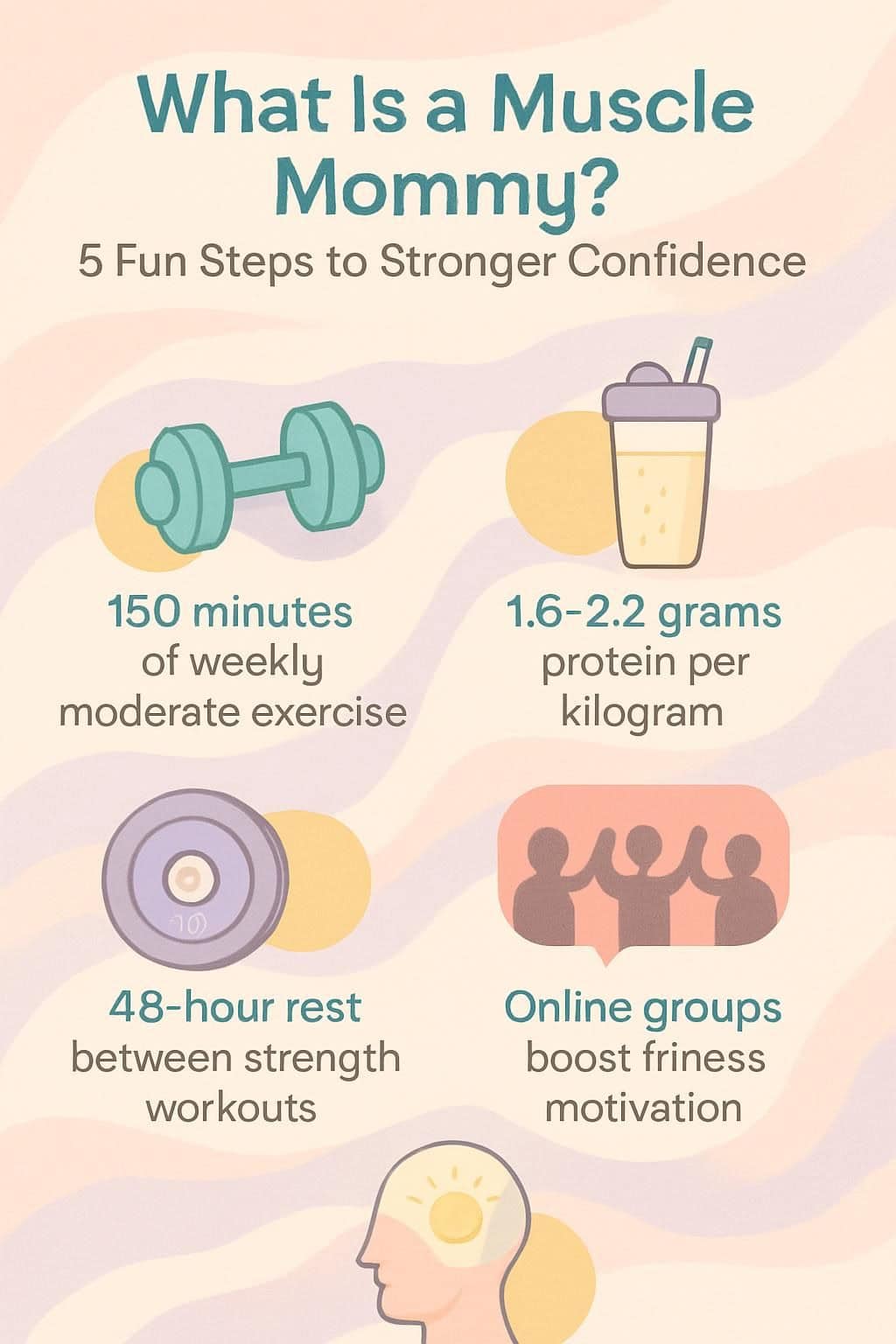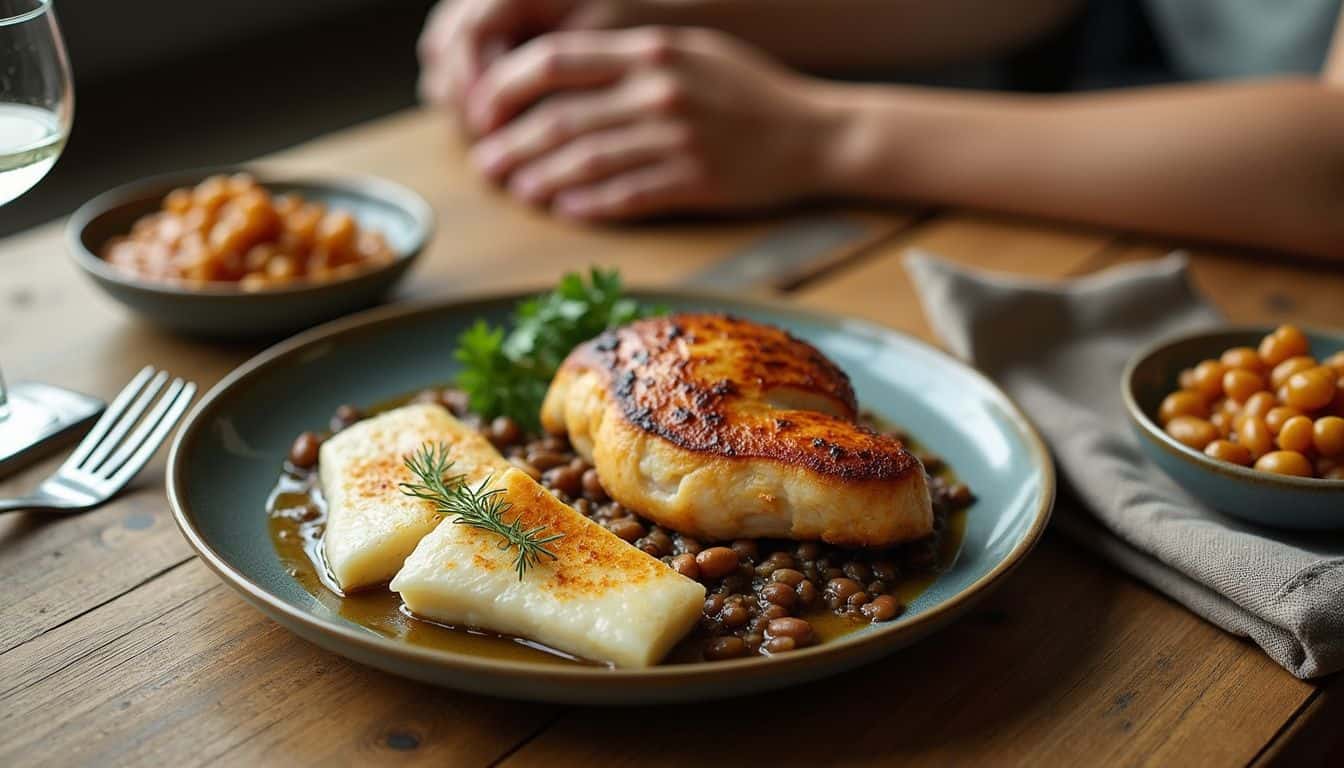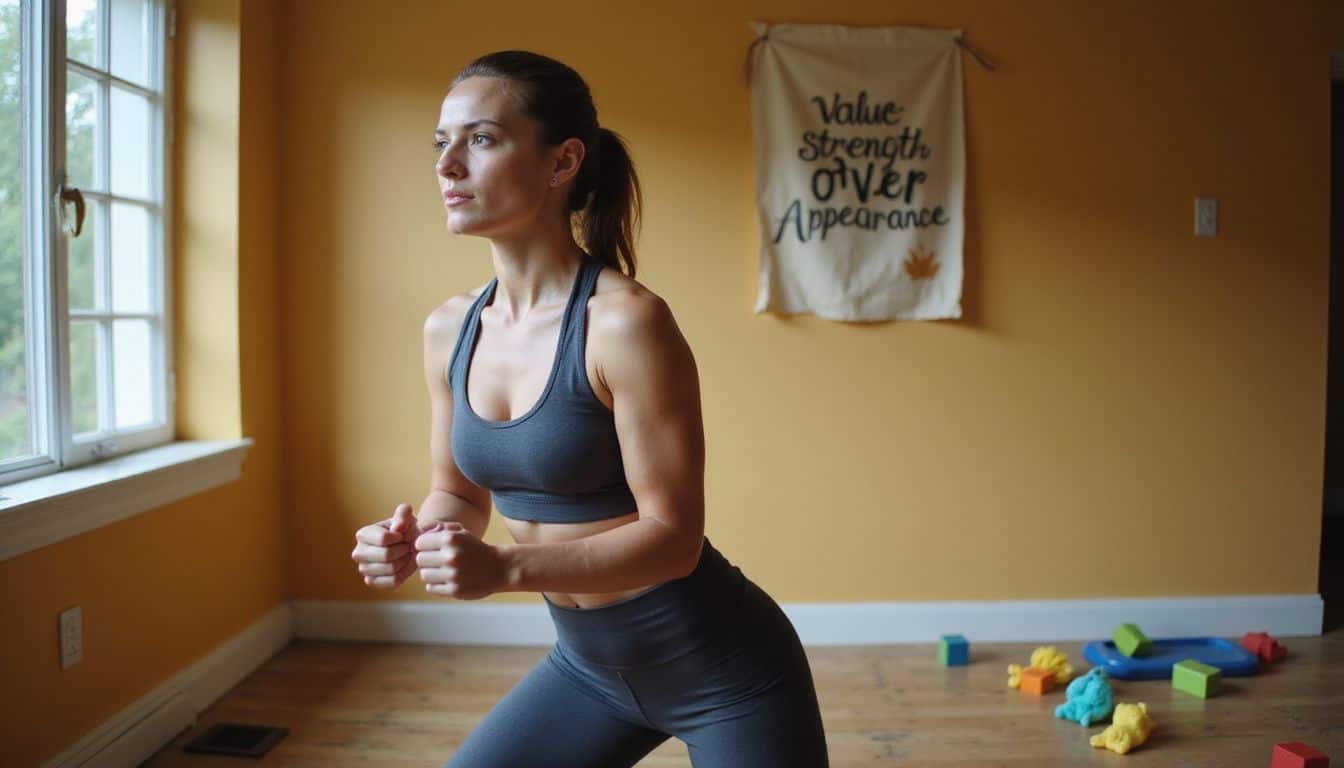Are you feeling unsure about your body image or fitness goals as a mom? The term “muscle mommy” describes women who proudly build strength, muscle mass, and confidence through resistance training and healthy living.
This article will clearly answer the common question: what is a muscle mommy, plus share five fun steps to help you feel stronger inside and out. Keep reading to lift your spirits—and some weights too!
Key Takeaways
A “Muscle Mommy” describes a woman who lifts weights to build strength while proudly celebrating her femininity—the term gained popularity across social media around 2021-2022.
Research confirms strength workouts help lower anxiety and tackle depression, prompting the CDC to advise adults to get at least 150 minutes of moderate exercise every week.
Fitness experts recommend getting between 1.6 and 2.2 grams of protein per kilogram of body weight each day to boost muscle growth, allowing a full 48-hour rest period before repeating workouts.
A 2022 Journal of Medical Internet Research study found online fitness groups help boost motivation, and a 2020 BMC Women’s Health study noted local exercise groups help lower stress levels.
The trend may continue growing into 2025—expanding into mental health awareness, comfortable and specialized workout gear, and increased gym childcare options for moms on-the-go.
Table of Contents
What Does “Muscle Mommy” Mean?

A “Muscle Mommy” is a woman who gains strength through weightlifting while proudly embracing her femininity and natural power. This term has recently exploded in popularity on platforms like Instagram, where women confidently display strong, powerful physiques.
Muscle Mommies typically favor compound exercises—such as squats and deadlifts—to build practical strength and fitness. They reject outdated ideas suggesting women stick exclusively to cardio, choosing instead to reshape their bodies and minds through strength training.
Yet this concept means more than building muscles and achieving a toned look. Muscle Mommies symbolize a new wave of female strength, empowerment, and personal confidence through physical fitness.

A great number of these women are actual moms who skillfully balance parenting with regular gym workouts—proving firsthand that motherhood and strength training easily coexist. This growing trend highlights body positivity and the positive mental effects women experience from consistent strength workouts.
I’ve personally witnessed my sister’s journey from mom of two kids, to proud Muscle Mommy—her higher energy levels, growing confidence, and positive mindset have completely reshaped her daily life.
Origin of the Term “Muscle Mommy”

Now that we get what “Muscle Mommy” is all about—let’s talk about how it started. The phrase took off on TikTok sometime around 2021-2022. People on social media began tagging strong, fit women who blend physical strength with nurturing vibes as “Muscle Mommy”.
Soon, the hashtag was everywhere, popping up on Instagram and Twitter too, drawing millions of views, likes, and shares. Fitness influencers especially got into it, claiming the term as their own since it mixed power-lifting routines with a warm, caring attitude that set them apart from old-school ideas about women in bodybuilding.
The popularity of “Muscle Mommy” points to a bigger cultural shift about women, fitness, and motherhood today. Although the phrase started within bodybuilding circles, it quickly went mainstream, representing something larger.
Women began sharing their meal prep photos packed with protein, clips of their strength workouts, and impressive progress posts, while pushing back against the outdated idea that mothers must put everyone else above themselves.
This wave is rejecting the notion that motherhood equals sacrificing your own strength and interests to serve others. Instead, it’s promoting the idea of becoming physically strong to foster emotional toughness and healthier self-care.
Strength isn’t just about lifting weights—it’s about lifting yourself up to become the person you want to be.
Characteristics of a Muscle Mommy

Muscle Mommies stand out with their strong bodies, fierce mindset, and glowing self-esteem that turns heads at the gym and beyond – read on to learn how these fitness-focused women balance barbells and life with equal grace.
Physical Strength and Fitness

Strong, fit moms build real strength with compound exercises like squats and deadlifts. I started lifting using just the empty bar—now, I’m pulling 185 pounds in my deadlift! The CDC (2023) recommends adults get at least 150 minutes of moderate exercise each week.
These strong women blend traditional weight training with high-intensity intervals, boosting stamina and overall fitness levels.
Eating right is essential to support intense workouts. Protein-rich foods repair and rebuild muscles after challenging sessions. My fitness changed dramatically once I began eating more whole foods and allowing proper recovery between workouts.
To help muscles heal fully, most strong moms wait at least 48 hours before training the same muscle group again, and they regularly get around 7-9 hours of sleep each night. Balancing activity with rest creates physical strength and sharper mental clarity.
For a solid, full-body routine, try using a rowing machine and boost your everyday functional fitness.
Confidence and Empowerment

Muscle Mommies glow with the unique confidence gained through physical strength. Each session builds inner power and boosts positivity across all areas of life. A Harvard T.H. Chan School study from 2021 found strength training helps reduce anxiety and depression.
I experienced this myself—after just six weeks of steady kettlebell exercises, I was happier, energized, and more productive in tackling daily activities.
Physical strength builds mental strength—the barbell lifts your spirit as much as your body.
This empowering journey isn’t only about looking good in workout clothes. It means setting personal goals, overcoming challenges, and feeling proud of your accomplishments. Many moms get trapped in daily routines and often become bored as a stay-at-home mom.
Strength workouts offer a refreshing escape from monotony and help build mental resilience. The muscle mommy trend challenges outdated beauty ideals, empowering women to define fitness in new and personal ways.
How to Become a Muscle Mommy

Becoming a Muscle Mommy takes five simple steps that will boost your strength and change how you see yourself – from setting smart fitness goals to making friends who lift you up (both weights and spirits).
Ready to flex those muscles and feel amazing?
Set Clear Fitness Goals

Having clear fitness goals gives your muscle mommy journey direction and purpose. At first, my fitness plan was pretty vague—just stuff like “get stronger”—and that didn’t really help.
Only after I wrote down actual targets did I start seeing real changes. The best goals follow the SMART approach: they are clear, measurable, realistic, meaningful, and have deadlines.
For instance, instead of just hoping to lift heavier weights, aim to “squat 150 pounds by June”. Breaking big goals into smaller weekly targets keeps things manageable and motivates you to stay on track.
Many women also find that keeping a fitness journal helps maintain momentum and inspires them, even on challenging workout days.
Strength training three to five times each week builds the foundation for muscle growth in aspiring muscle mommies. Your body relies on regular workouts to develop lean mass. My own routine includes compound exercises, such as squats and deadlifts, to target multiple muscles at once.
Nutrition matters too—it’s important to eat enough protein, around 1.6 to 2.2 grams per kilogram of body weight daily, to help your muscles recover. Using this nutrition strategy, I achieved visible muscle definition in about three months.
Clearly defining a move goal to lose weight or gain strength gives each workout real purpose and makes your efforts count.
Focus on Strength Training

You’ve set your fitness goals, so now it’s about building strength. Strength training is the foundation of every muscle mommy’s fitness journey. Start simple with basic compound moves—think squats, deadlifts, and lunges.
These workouts target several muscle groups at the same time, giving you better results with less effort. Initially, going lighter worked well for me; it helped me get the form right before I moved up to heavier weights.
Aim for about 8 to 12 repetitions per set. This range gives you solid strength gains and builds lean muscle without overdoing things. Beginner-friendly routines like MAPS Anabolic can help guide you step by step.
Don’t stress about becoming overly muscular—strength training actually creates a sleek, toned appearance and revs up your metabolism. Even your mental health gets a boost! My mood got noticeably better after just two weeks of steady lifting.
Grab kettlebells or resistance bands, start moving, and soon you’ll notice your confidence rise along with your strength.
Prioritize Nutrition and Recovery

Building strength takes more than tough workouts—it also depends on proper rest and good nutrition. After intense training sessions, muscle growth occurs in recovery, not during exercise itself.
Fill your meals with lean proteins like chicken, fish, beans, and lentils, since these foods help repair muscle tissue damaged by exercising.
Recovery is where the magic happens. Sleep is your superpower.
Rest matters just as much as your workouts, so allow muscles at least 48 hours between hard training sessions for recovery. The American Heart Association supports this rest period to boost effective results.
Aim to sleep around 7-9 hours each night, as enough rest helps balance hormones and repair muscle tissue. Plenty of fitness-focused moms also sip whey protein shakes to speed muscle healing.
Studies reveal these supplements reduce muscle soreness and shorten recovery periods. Strength and shape develop while resting—not during heavy exercise.
Community and Support for Muscle Mommies

Muscle Mommies thrive through strong bonds with others on the same path. Finding your fitness tribe can boost your progress and keep you going when workouts get tough.
Online Communities and Social Media

Social media has become a lifeline for “Muscle Mommies” to connect, share, and grow. Platforms like Instagram, TikTok, and Facebook feature daily workout routines, healthy meal suggestions, and inspiring success stories from women on similar paths.
Last year, I joined a Facebook group for fitness-focused moms, and the support transformed my entire approach. Seeing videos of other moms lifting heavy weights or tackling intense HIIT sessions pushed me to test my limits with exercises I hadn’t even considered before.
A study from 2022 published in the Journal of Medical Internet Research supports this experience, noting that online fitness groups significantly boost motivation and regular exercise habits.
Many members often post workout clips dressed in comfortable moisture-wicking leggings and athletic tops, openly sharing both challenges and accomplishments.
These digital communities break barriers for busy moms who can’t always find time to reach fitness centers. Real-life stories and authentic content from everyday mothers foster a sense of connection and encouragement gym memberships alone can’t provide.
Moms swap favorite protein powder suggestions, comfy athleisure outfits, and strategies to squeeze quick exercises between parenting responsibilities. The fitness journey becomes less about chasing a perfect figure and more about improving health and strength.
Online celebrations for small victories—like finishing five push-ups or trying Olympic lifting—spark powerful motivation. With steady encouragement from these supportive communities, women find strength to overcome common obstacles that might derail their fitness goals.
Local Fitness Groups

Local fitness groups can greatly boost your progress and motivation as a muscle mommy. These meetups create supportive spaces where women encourage each other during challenging workouts—and through personal ups and downs.
Last year, I joined a morning boot camp that pushed me much further than working out alone. Soon, my classmates became close friends who checked in whenever I missed a session. According to a 2020 BMC Women’s Health study, peer encouragement in fitness groups lowers stress and builds self-belief among mothers.
Today, many gyms offer classes specifically designed for moms, scheduled conveniently around school drop-offs and pick-ups. CrossFit gyms, Pilates studios, and local running groups warmly welcome women at every fitness level.
Members frequently exchange useful tips on healthy eating, comfortable sports bras, and effective recovery techniques. Combining exercise with friendship, these local groups offer far more than physical fitness—they become an enjoyable, essential part of daily life and well-being.
Challenges and Misconceptions
Muscle mommies face outdated ideas about what strong women should look like. Many people still think women who lift weights will get “too bulky” or that moms should focus on cardio instead of strength training.
Breaking Stereotypes

Moms with muscles challenge old ideas about how mothers ought to look. Society often pushes women to select either femininity or strength—but this fake choice limits women’s full potential.
Today, plenty of moms lift weights, build strength, and proudly embrace motherhood. The fitness scene has typically favored men, yet women in bodybuilding and powerlifting are quickly shifting that truth.
Strong, muscular women frequently face unfair judgments for appearing “too masculine”, or not being “mom enough”. These outdated opinions overlook the simple fact that building physical strength also boosts mental resilience.
Strength training actually equips moms to better manage motherhood demands. By focusing on performance rather than appearance, they demonstrate to their kids the importance of self-esteem and healthy living.
For muscular moms, tackling stereotypes about their everyday choices remains the next big hurdle.
Addressing Criticism

Muscle mommies often encounter criticism from those who think the trend promotes unrealistic body standards. Some critics worry that women will feel pressured, after having children, to achieve a particular appearance.
I’ve personally seen this situation at my gym—new mothers expressing guilt over not regaining their fitness fast enough.
But this movement celebrates strength, not beauty. Supporters highlight that muscle moms define strength differently: some lift heavy weights, while others manage strength by holding toddlers all day long.
This shift pushes back against narrow ideals and proves moms have diverse ways to feel powerful.
Your fitness journey needs to reflect your own goals and desires—not someone else’s opinion of a mother’s ideal look. Clearly defined fitness objectives help you follow your chosen path, building confidence through consistent exercise routines.
How Will the “Muscle Mommy” Trend Evolve in 2025?

The Muscle Mommy trend will expand beyond physical strength by 2025. We’ll notice a stronger emphasis on mental wellness paired closely with physical workouts—creating a balanced approach to health.
Social media platforms will support this shift, forming specialty groups for moms who lift and love sharing their progress. Fitness brands will respond by creating workout clothing using moisture-wicking fabrics designed explicitly with strong mothers in mind, moving past outdated “thin is in” beauty standards.
Experts expect a rise in strength-training programs targeted at moms with busy schedules. These will likely include short, high-intensity interval workouts. More gyms will introduce childcare services too, helping mothers find time to train regularly.
Fitness specialists at Unfinished Man predict muscle selfies will become a common practice among moms. Posting these selfies helps mothers track their strength progress and build confidence.
The trend will shift its focus from simply looking strong to genuinely feeling strong—with greater recognition of how workouts can positively affect both overall well-being and family life.
People Also Ask
What is a muscle mommy?
A muscle mommy is a mom dedicated to building physical strength and staying fit. She balances parenting with strength workouts—lifting weights, bodyweight exercises, and staying active—to build muscle tone and boost self-confidence.
How can moms start their muscle mommy journey?
Begin with easy compound exercises, such as squats, lunges, and push-ups. Set clear fitness goals, get comfy running shoes and workout clothes, and fit short, regular workouts into your daily schedule. Small steps, done often, create lasting progress.
What diet tips help muscle mommies see results?
Aim for balanced eating, rich in protein to help muscles grow stronger. Many fitness-conscious moms add protein powders into shakes or meals for an extra nutritional boost. Drink plenty of water, plan your meals ahead, and keep healthy snacks handy to maintain energy levels.
Can busy moms really find time for fitness?
Yes, even busy moms can make fitness work with quick, high-intensity interval training (HIIT). Researcher Martin Gibala found that HIIT sessions provide similar fitness benefits to longer workouts—in far less time—which fits perfectly into a hectic parenting schedule.
What mental benefits come with becoming a muscle mommy?
The muscle mommy lifestyle helps moms develop discipline and believe more strongly in their abilities—going beyond just physical strength. Moms who regularly exercise often describe feeling calmer, happier, and more confident. Exercise science confirms that staying active boosts mental well-being as much as physical health.
Is the muscle mommy trend supported by health experts?
Yes indeed—it’s backed by major health organizations such as the Centers for Disease Control and the American Academy of Pediatrics. These experts encourage active lifestyles for moms, noting that physically active mothers often raise children who become healthier, creating a cycle of family wellness.
